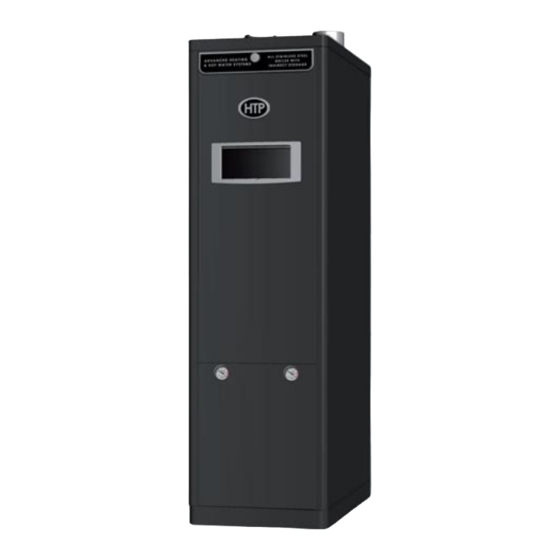
HTP EFTC-140F User Manual
Elite fire tube combi floor and wall mount models
Hide thumbs
Also See for EFTC-140F:
- Service manual (112 pages) ,
- Manual (75 pages) ,
- Installation manual (89 pages)
Table of Contents
Advertisement
NOTICE: HTP reserves the right to make product changes or updates without notice and will not be held liable for typographical errors
in literature.
NOTE TO CONSUMER: PLEASE KEEP ALL INSTRUCTIONS FOR FUTURE REFERENCE.
IF THE INFORMATION IN THIS MANUAL IS NOT FOLLOWED EXACTLY, A FIRE OR EXPLOSION MAY RESULT, CAUSING
PROPERTY DAMAGE, PERSONAL INJURY, OR LOSS OF LIFE. DO NOT STORE GASOLINE OR OTHER FLAMMABLE VAPORS
AND LIQUIDS IN THE VICINITY OF THIS OR ANY OTHER APPLIANCE.
Do not try to light any appliance.
Do not touch any electrical switch.
Do not use any phone in your building.
Immediately call your gas supplier from a neighbor's phone. Follow the gas supplier's instructions.
If you cannot reach your gas supplier, call the fire department. Installation and service must be provided by a qualified installer,
service agency, or the gas supplier.
120 Braley Rd. P.O. Box 429
Elite Fire Tube Combi
WHAT TO DO IF YOU SMELL GAS
East Freetown, MA 02717-0429
Floor and Wall Mount Models
USER'S INFORMATION
MANUAL
Models
EFTC-140F / 199F
EFTC-140W / 199W
www.htproducts.com
LP-495 REV. 1.21.16
Advertisement
Table of Contents
Troubleshooting

Subscribe to Our Youtube Channel
Summary of Contents for HTP EFTC-140F
- Page 1 EFTC-140F / 199F EFTC-140W / 199W NOTICE: HTP reserves the right to make product changes or updates without notice and will not be held liable for typographical errors in literature. NOTE TO CONSUMER: PLEASE KEEP ALL INSTRUCTIONS FOR FUTURE REFERENCE.
- Page 2 LP-495 Rev. 1.21.16...
- Page 3 The following defined terms are used throughout this manual to bring attention to the presence of hazards of various risk levels, or to important product information. DANGER indicates an imminently hazardous situation which, if not avoided, will result in death or serious injury. WARNING indicates a potentially hazardous situation which, if not avoided, could result in death or serious injury.
-
Page 4: Table Of Contents
TABLE OF CONTENTS PART 1 – PRODUCT AND SAFETY INFORMATION ..........................4 A. BEFORE OPERATION ..................................5 B. DURING OPERATION ..................................5 C. TROUBLESHOOTING AND GENERAL CAUTIONARY STATEMENTS ................... 6 PART 2 – MAINTENANCE ..................................7 A. SERVICE TECHNICIAN ..................................7 B. -
Page 5: Before Operation
A. BEFORE OPERATION Check the Gas Type (NG/LP) When operating the appliance for the first time, ensure the connected gas type matches that of the gas type of the appliance. Check whether the gas supplied is NG or LP. The appliance gas type is indicated on the rating plate on the side of the appliance. -
Page 6: Troubleshooting And General Cautionary Statements
C. TROUBLESHOOTING AND GENERAL CAUTIONARY STATEMENTS DO NOT use this appliance for any purposes other than those specifically described by HTP, Inc (to provide central heating and domestic hot water). Using this appliance for unapproved purposes WILL VOID the warranty, and could result in property damage, serious personal injury, or death. -
Page 7: Part 2 - Maintenance
Hydronic systems that use glycol as heat transfer fluid must be serviced periodically. Glycol can break down over time, become acidic, and attack gaskets and seals in appliances. This can result in property damage, severe personal injury, or death. Each glycol manufacturer has different recommendations for testing and replacement. Do not test glycol quality yourself. Have your qualified service technician check glycol quality during annual servicing. -
Page 8: Part 3 - Maintenance Procedures
Check and remove any blockage from the outdoor exhaust vent and intake pipe terminations. DO NOT perform this maintenance if exhaust vent and intake pipe terminations are in difficult to reach locations. Check the CH and DHW loop pressure gauges. Normal CH pressure will range from 15 – 30 psi. Normal DHW pressure will range from 20 –... -
Page 9: Monthly Maintenance - To Be Performed By Owner
Check Pressure Gauges Check the CH and DHW loop pressure gauges. Normal CH pressure will range from 15 – 30 psi. Normal DHW pressure will range from 20 – 150 psi. Appliance will not operate if pressure is lower than 15 psi. ... -
Page 10: Annual Maintenance - Only To Be Performed By A Qualified Service Technician
again to attempt to clean the valve seat. If the valve does not properly seat and continues to weep, contact a qualified service technician to inspect the valve and system. Repeat the process on the other valve. If water does not flow from the valve when you completely lift the lever, the valve or discharge line may be blocked. Immediately shut the appliance down per instructions on page 2 and call a qualified service technician to inspect the valve and system. -
Page 11: Maintenance Notes
Er:80 will occur if there is no water in the appliance. Ensure the appliance is full of water and purged of excess air. Then manually reset the appliance by pressing the power button. If the error continues to occur, call a qualified service technician. Failure to do so could result in property damage. - Page 12 LP-495 Rev. 1.21.16...















Need help?
Do you have a question about the EFTC-140F and is the answer not in the manual?
Questions and answers